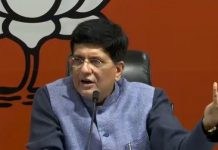I set about exploring these characters and their world, roping in Meren Imchen as a collaborator. Meren, who is a really talented animator and illustrator, took the idea far beyond the images I had in my head, and we put together a six-page comic that appeared in Man’s World in their September 2005 issue. I did have a larger story in mind, though. So after I finished my book on Indian poster artists, The Art of Bollywood, I returned to the idea. Eventually we ended up expanding the initial preview into a full-length book.
Why a chimpanzee as a protagonist? Why tell a story through the eyes of an animal instead of a human?
Having researched Indian B-movies a fair bit, I do know something about oddball animal movies and stars in Bollywood. But the book isn’t really about animals as such; I have very little interest in the Maneka Gandhi side of things as it were. I suppose what I’ve done is use the animals as a device, a way of telling the stories of the Bollywood characters I’ve met through the years. All the would-bes and the has-beens, all the fringe players who could have been stars if fate hadn’t dealt them a lousy hand. Their stories can be sad, tragic, but also incredibly funny at times. I discovered I could capture this mix of emotions by telling the stories through animal characters.
You get the sense from meeting these people that having peddled stories throughout their careers, they are now down to telling one last story — the story of their own lives. I’ve woven some of their narratives together to tell what is hopefully a universal story — about how we construct a self by aping and mimicking others. How we play all these roles in life, which are like so many ill-fitting costumes. The rage and self-loathing, this act can provoke within us. What happens in mid-life, when you grow tired of the performance, when the pretence is exhausted. Why a chimp? There’s this idea in the book, that we’re all performing monkeys in a way, dancing to some unseen madari’s rhythms.
Tell us about your collaboration with Meren Imchen. What role did each of you have to play?
I wouldn’t have attempted this book if I hadn’t discovered Meren’s work. He hadn’t done much in this style earlier, but he understood what I had in mind very quickly. And then with great intuition and empathy for the character, he went beyond my vision to create an entire world. Having grown up in Nagaland, at the periphery of Bollywood’s influence, he didn’t know much about the setting at first. But he never allowed that to become a limitation in any way. My job was to write down the images as I saw them in my head, put together some references here and there, and leave the rest to him. Our conversations were more about character, about expressing the emotions behind a scene.
What’s the market now for graphic novels in India? Has it evolved?
Definitely. Back in the Nineties, I wanted to do a graphic novel based on my character Quick Gun Murugun. I worked with a couple of very talented artists and we put together some excellent pages, but somehow the project never got off the ground. This was before anyone had ever done a graphic novel in India, so perhaps the idea was ahead of its time. Or perhaps it was an idea that belonged on a screen, not on the page.
As for the current scene, I think there’s some very good work out there. And whatever you may think of the actual event, it’s great that you can hold a Comic Con now. People sometimes have this jaded view of things — ‘Oh, you’re doing a graphic novel? Everybody’s doing a graphic novel’ — but given the fact that we’re such a hugely visual culture, there should be a lot more titles, a lot more going on.
One grouse — I see no reason why the scene should be restricted to English-language titles. A Bhimayana should be translated into every Indian language, so should something like Orijit Sen’s superb work on Kabir. My own book is partially in Hindi, because it’s only natural that Bollywood characters should speak in the language of their films. It isn’t common practice to mix languages in this fashion. But I don’t see why one can’t do in the Indian graphic novel what Junot Diaz does in his fiction, switch between languages as one pleases.
Have you drawn inspiration from actual Bollywood stars/filmmakers for your character?
The book is set in a shadow Bollywood, a parallel world where chimps and dogs are movie stars. Once in a while, the real world breaks through. Sudershan assaults Dilip Kumar with a leg of chicken at Gaylord restaurant. Raj Kapoor considers him for a role in Mera Naam Joker, and then rejects him.
Aradhna Wal is a Sub-Editor with Tehelka.
aradhna@tehelka.com












